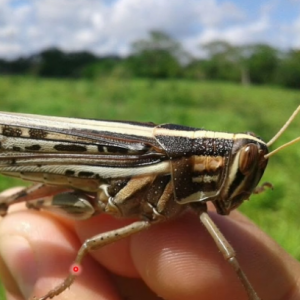
To successfully realize our work at the Global Locust Initiative (GLI), we engage globally with collaborators living and working with locusts and grasshoppers locally in their communities. Among our list of fantastic partners, we can count Mario Poot Pech of the Yucatán State Committee of Plant Health (CESVY), based in Merida, Mexico. Mario holds a PhD from the Mexican Technological University in Conkal, Yucatán and is an internationally recognized expert on the Central American locust, Schistocerca piceifrons piceifrons Walker, a significant locust pest in parts of Mexico and neighboring countries.
Mario currently represents Mexico for the Regional Organization of Agricultural and Livestock Health (OIRSA), a partnership of 9 Central American countries and international agencies. As part of their regional mandate, OIRSA facilitates a variety of activities in support of better pest management across the agricultural system. In support of these activities, OIRSA regularly hosts trainings to share information about various pests and their management. Recently, Mario participated in an educational OIRSA webinar about the Central American locust (starting at approximately 14:30).
The webinar provides information (in Spanish), about Orthoptera classification, monitoring and sampling the Central American locust to determine best management strategies, various biological and chemical control options, and current challenges facing the management of this species. Like other locusts, the Central American locust is one of a few grasshopper species with the capability to become gregarious. In the gregarious state, locusts change their colors and behaviors, often forming large, migrating swarms with the potential to cause significant crop losses.
The Central American locust frequently feeds on a variety of different crops, including corn, one of the most important staple crops for many people across the region. According to Mario’s presentation, the locust has two generations per year in the Yucatán peninsula, with the locust life cycle often corresponding with corn planting in this rain-fed agricultural system. Because of the vulnerability of seedlings early in the corn season, the locust can cause significant crop losses for many farmers.
Mario and others working with the locust in Mexico and Central America recommend regular crop monitoring as part of a preventative pest management strategy. Effective monitoring includes a variety of strategies such as site visits, unmanned aerial vehicles, and the use of satellites with normalized difference vegetation index data.
With an accurate assessment of the presence and abundance of locusts in the field, Mario recommends identifying appropriate management practices when the number of locusts reach medium (11-29 individuals per 100m2) or high (greater than 30 individuals per 100m2) thresholds. Such management strategies may include the use of biological control methods such as entomopathogenic (insect-killing) fungi or chemical control options. For all control options, it is essential to identify appropriate safety protocols and follow all recommendations provided for the specific crop in which the product is used.
The webinar ends with Mario discussing a few challenges associated with the Central American locust, such as identifying alternative uses for locusts. Mario is particularly interested in locusts as a source of protein in animal feed and continues to research in this area. We encourage you to watch the webinar or contact Mario directly for more information and we will continue to provide updates about Mario and OIRSA’s work.
If you have any news for the GLI, please contact us so we can share your information with the locust and grasshopper community!